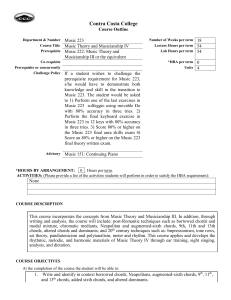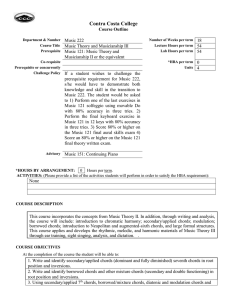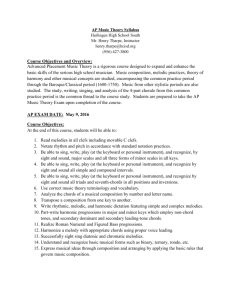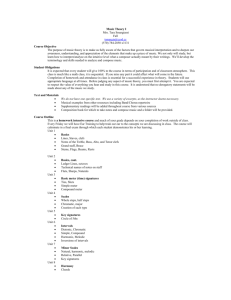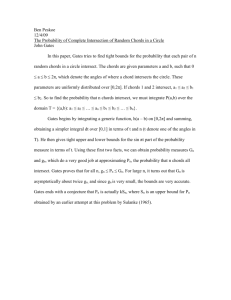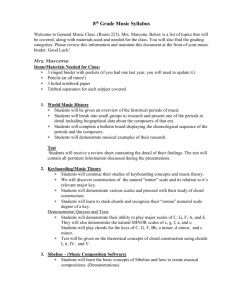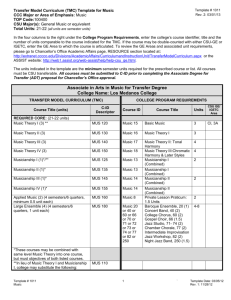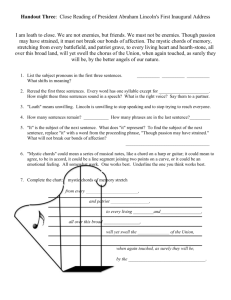MUSIC 121-F12 - Contra Costa College
advertisement
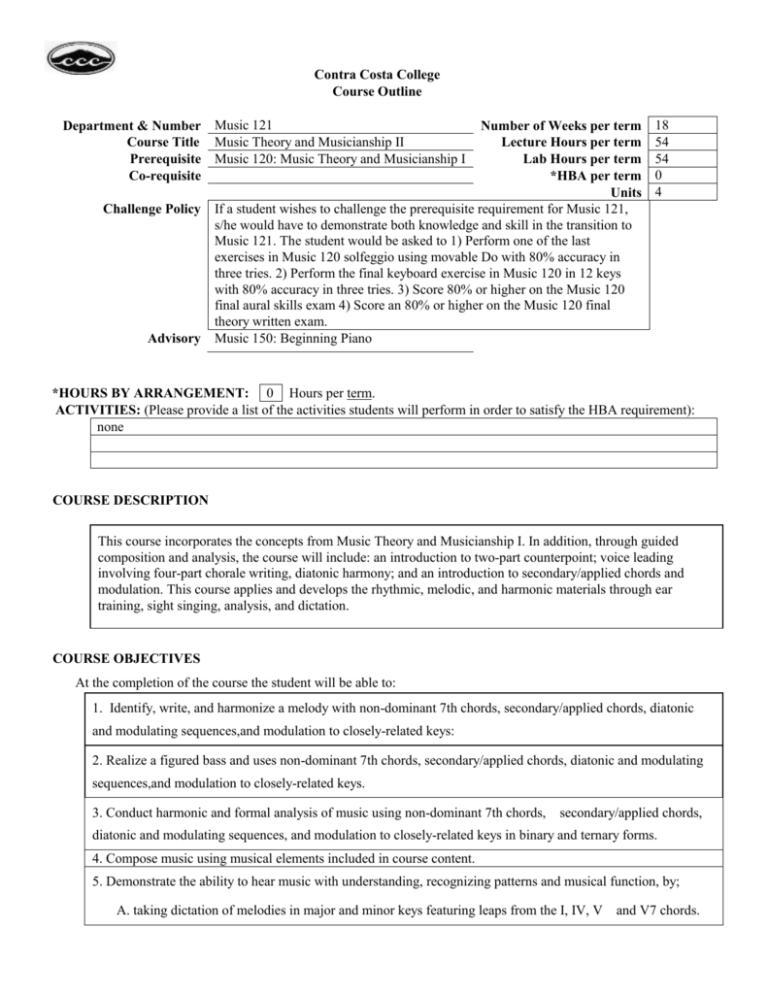
Contra Costa College Course Outline Department & Number Music 121 Course Title Music Theory and Musicianship II Prerequisite Music 120: Music Theory and Musicianship I Co-requisite Number of Weeks per term Lecture Hours per term Lab Hours per term *HBA per term Units Challenge Policy If a student wishes to challenge the prerequisite requirement for Music 121, s/he would have to demonstrate both knowledge and skill in the transition to Music 121. The student would be asked to 1) Perform one of the last exercises in Music 120 solfeggio using movable Do with 80% accuracy in three tries. 2) Perform the final keyboard exercise in Music 120 in 12 keys with 80% accuracy in three tries. 3) Score 80% or higher on the Music 120 final aural skills exam 4) Score an 80% or higher on the Music 120 final theory written exam. Advisory Music 150: Beginning Piano 18 54 54 0 4 *HOURS BY ARRANGEMENT: 0 Hours per term. ACTIVITIES: (Please provide a list of the activities students will perform in order to satisfy the HBA requirement): none COURSE DESCRIPTION This course incorporates the concepts from Music Theory and Musicianship I. In addition, through guided composition and analysis, the course will include: an introduction to two-part counterpoint; voice leading involving four-part chorale writing, diatonic harmony; and an introduction to secondary/applied chords and modulation. This course applies and develops the rhythmic, melodic, and harmonic materials through ear training, sight singing, analysis, and dictation. COURSE OBJECTIVES At the completion of the course the student will be able to: 1. Identify, write, and harmonize a melody with non-dominant 7th chords, secondary/applied chords, diatonic and modulating sequences,and modulation to closely-related keys: 2. Realize a figured bass and uses non-dominant 7th chords, secondary/applied chords, diatonic and modulating sequences,and modulation to closely-related keys. 3. Conduct harmonic and formal analysis of music using non-dominant 7th chords, secondary/applied chords, diatonic and modulating sequences, and modulation to closely-related keys in binary and ternary forms. 4. Compose music using musical elements included in course content. 5. Demonstrate the ability to hear music with understanding, recognizing patterns and musical function, by; A. taking dictation of melodies in major and minor keys featuring leaps from the I, IV, V and V7 chords. B. taking dictation of rhythms with subdivided beats in simple and compound meters. C. taking harmonic dictation of common diatonic progressions with inversions, writing outer voices and Roman Numerals. 6. Demonstrate the ability to "audiate" a musical score by: A. sight reading and performing rhythms with subdivided beats in simple and compound meters. B. sight singing melodies in major and minor keys featuring, leaps from the I, IV, V and V7 chords. COURSE CONTENT: (In detail; attach additional information as needed and include percentage breakdown) 10 % Theory: diatonic chords, basic cadential formulas and phrase structure 10 % Theory: dominant seventh chords 5 % Theory: figured bass 2.5 % Theory: non-harmonic tones 10 % Theory: introduction to two-part counterpoint 10 % Theory: voice leading involving four-part chorale writing 5 % Theory: non-dominant 7th chords 5 % Theory: introduction to secondary/applied chords 2.5 % Theory: introduction to modulation 10 % Musicianship: preparation, sight singing, and transposition of melodies in major and minor keys featuring leaps from the I, IV, V and V7 chords. 10 % Musicianship: melodic dictation in a variety of major and minor keys, tempos, and meter signatures featuring leaps from the I, IV, V, and V7 chords 2.5 % Musicianship: dictation of rhythms with subdivided beats in simple and compound meters at various tempos. 2.5 % 5 10 % % Musicianship: sight reading and performance of music in multiple parts (canons, duets, chorales, etc.) appropriate to the topics studied. Musicianship: exercises to detect errors in rhythm, pitch, harmony, and/or solfeggio. Musicianship: exercises at the piano keyboard, such as playing chord progressions while singing any part or arpeggiations of the chords. METHODS OF INSTRUCTION Theory: Written exercises, projects, and exams. Musicianship: in-class sight singing and dictation drills Musicianship: in-class drills in rhythmic accuracy, conducting, and/or keyboard Musicianship: directed listening activities/exams Musicianship: individual sight singing examinations Musicianship: rhythmic, melodic, and harmonic dictation exercises/exams Musicianship: self-paced individual laboratory work INSTRUCTIONAL MATERIALS Textbook Title: Author: Publisher: Edition/Date: Textbook Title: Harmony and Voice Leading Edward Aldwell, Carl Shachter and Allen Cadwallader Thomson/Schirmer 4th Edition, 2011 Music for Sight Reading Author: Thomas Benjamin, Michael Horvit and Robert Nelson Publisher: Schirmer Engage Edition/Date: 5th Edition, 2009 NOTE: To be UC transferable, the text must be dated within the last 5 years OR a statement of justification for a text beyond the last 5 years must be included. COURSE EXPECTATIONS (Use applicable expectations) Outside of Class Weekly Assignments Weekly Reading Assignments Weekly Writing Assignments Weekly Math Problems Lab or Software Application Assignments Other Performance Assignments Hours per week 2 3 0 3 2 STUDENT EVALUATION: (Show percentage breakdown for evaluation instruments) 20 % Theory: Written homework assignments 10 % Theory: Class projects 30 % Theory: Written examinations 10 % Musicianship: Self-paced lab assignments 10 % Musicianship: Piano performance examinations 10 % Musicianship: Aural dictation examinations 10 % Musicianship: Musicianship performance examinations GRADING POLICY (Choose LG, CR/NC, or SC) Letter Grade 90% - 100% = A 80% - 89% = B 70% - 79% = C 60% - 69% = D Below 60% = F Prepared by: Wayne L. Organ Date: April 14, 2013 Form Revised 01/13 Pass / No Pass 70% and above = Pass Below 70% = No Pass X Student Choice 90% - 100% = A 80% - 89% = B 70% - 79% = C 60% - 69% = D Below 60% = F or 70% and above = Pass Below 70% = No Pass
